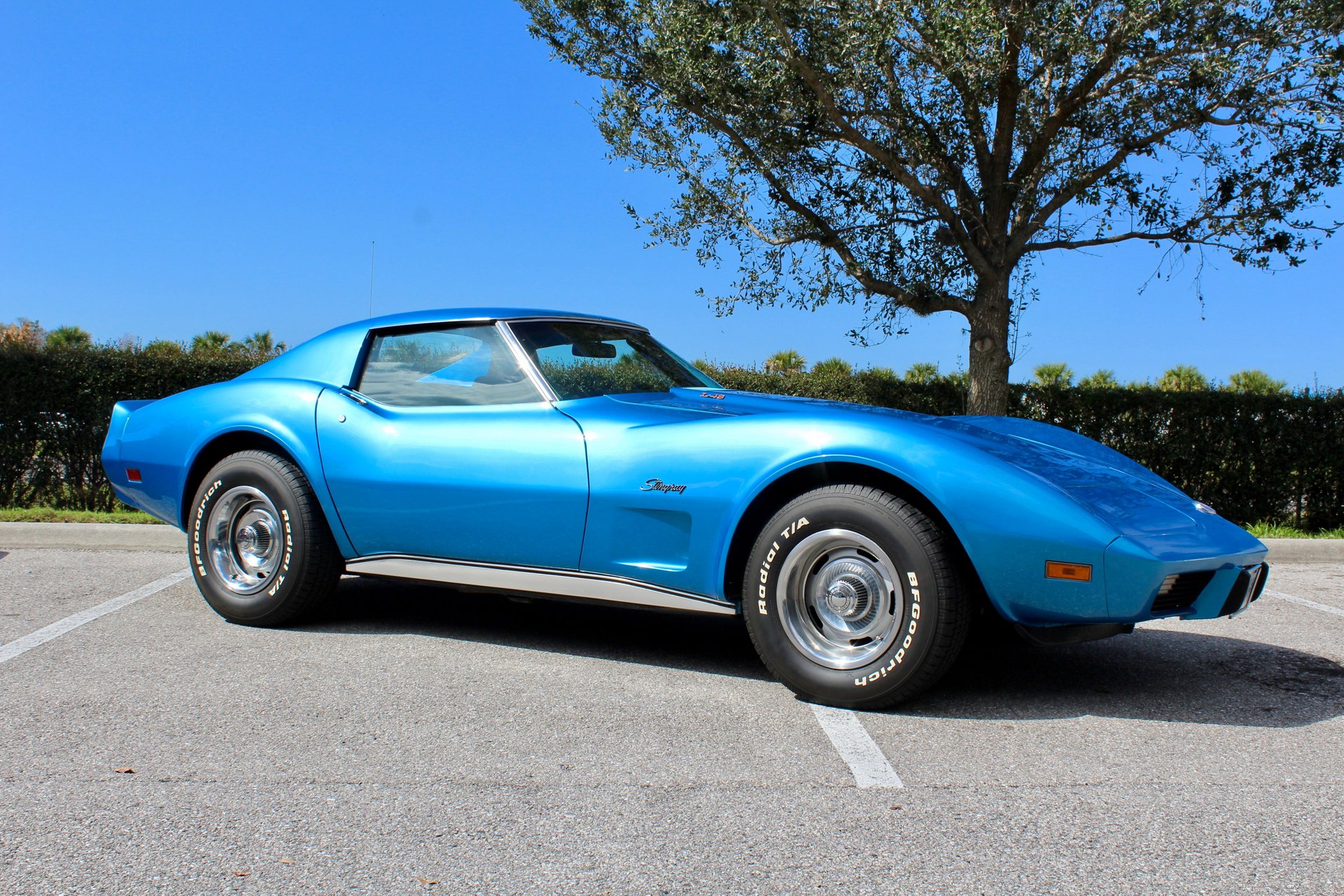Corvette History 
Select a year and a model to view the vast history of Corvettes.
Coupe

Unlike some companies, Chevrolet was accurate in advertising the fiberglass-bodied Corvette as “America’s only true production sports car.”
The 1976 Corvette coupes had VINs 1Z37[ ]6S400001 to 1Z37[ ]6S446558. The first symbol 1 indicated Chevrolet. The second symbol identified the body series Z=Corvette. The third and fourth symbols indicated the body style number 37=coupe. The fifth symbol [in blank] indicates engine: L=350-cid 180-hp V-08; X=350-cid 210-hp V-8. The sixth symbol indicates the model year 6=1976. The seventh symbol identifies the assembly plant S=St. Louis. The last six symbols indicate the sequential production number.
The big-block V-8 had disappeared after 1974, leaving a 350-cid (5.7-liter) small-block as the power plant for all Corvettes. Two versions were offered this year, both with a four-barrel carburetor. The base L48 version now developed 180 hp (15 more than in 1975). An optional L82 V-8 produced 21- hp. The L82 had special heads with larger valves, impact-extruded pistons and finned aluminum rocker covers.
The standard V-8 drove a new, slightly lighter wright automatic transmission: the Turbo Hydra-Matic 350, which was supposed to improve shifting at wide-open throttle. The optional engine kept the prior Turbo Hydra-Matic 400, but with a revised torque converter. A wide-range four-speed manual gearbox (with 2.64:1 first gear ration) was standard and a close-ratio version was available at no extra cost. A new Carburetor Outside Air Induction system moved intake from the cowl to above the radiator.
No longer offered this season was a Corvette convertible. It had been dropped at the end of 1975. Only the Stingray coupe remained. It had twin removable roof panels. The Corvette’s base retail price was $7,805, so this was the first year that the sticker past both $7,000 and $7.500. By year’s end, 46,558 Corvette were built.
A partial steel underbody replaced the customary fiberglass underbody in 1976. This was done to add strength and improve shielding from exhaust system heat. This can be a problem for restorers, as the underbody can rust. However reproductions are now available.
A new one-piece bar Corvette nameplate was seen on the rear of the car between the twin-unit taillights (which were inset in the bumper cover). Of the 10 body colors, eight were Corvette exclusives. Corvettes had side marker lights with reflectors, parking lamps that went on with the headlights, lane-change turn signals and two-speed wiper/washers. Inside was a new, smaller diameter four spoke sports steering wheel with crossed-flags medallion. This wheel actually came from the Chevrolet Vega subcompact. Not everyone appreciated its lowly origin, so it lasted only this year. A grained vinyl-trimmed instrument panel (with stitched seams) held a 16-mph speedometer with trip odometer and 7,000-rpm electronic tachometer. A key lock in the left front fender set the anti-theft alarm.
Corvettes had fully-independent suspension and four-wheel disc brakes. Wide GR70 tires rode 15 x 8-inch wheels. A total of 5,368 Corvettes had the FE7 Gymkhana suspension installed. 5.720 came with the L82 V-8 and 2,088 had the M21 four-speed close-ratio manual gearbox. Cast-aluminum wheels were a new option, installed on 6,253 cars. Standard equipment included bumper guards, flush retracting headlights, Soft-Ray tinted glass, Hide-A-Away wipers, wide-view day/night mirror and a center console with lighter and ashtray. Behind the seat backs were three carpeted storage compartments. The Corvette bucket seats had textured-vinyl upholstery and deep=pleated saddle-stitched seat panels.
This year’s factory show car was the 1976 Corvette Mulsanne. It was a customized update of the Aero Coupe with stationary headlights under transparent covers. It had twin NASA-style hood scoops on either side of the power blister in the center of the hood, a ZL-1 V-8, external side exhausts with ribbed covers, a periscope-style roof treatment and dual high-mounted rear view mirrors. The hood was finished with stylized frames and the car was photographed wearing the Michigan Bicentennial license plates.
Corvettes again dominated sports car racing events. Gene Bothello took the A-Production title, Howard Park to the B-Production honors and Orin Butterick was the B-Stock Solo II champion.
Here is some 1976 Corvette trivia:
Though largely a carryover from 1975, the new Corvette set an all-time sales record.
The suggest retail price for the base Corvette coupe cracked the $7.000 barrier for the first time - and the $7,500 barrier, too.
Car and Driver (April 1976) also tested an L82 Corvette with the M40 transmission and 3.36:1 rear axle. It went from 0-to-30 mph in 2.8 seconds, 0-to-60 mph in 7.1 seconds and 0-to-100 mph in 19.95 seconds. In the the standing start quarter mile in 15.3 seconds at 91.9 mph. It had at top speed of 124.5 mph.
A sealed battery was standard for the first time this year.
Kelsey-Hayes aluminum wheels were reintroduced on the 1976 Corvette. They looked like the aluminum wheels used on earlier models, but carried "Made in Mexico" stamping on their interior surface.